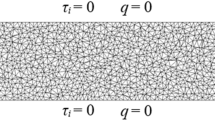Abstract
The space-time separated representation method (Ladevèze, C. R. Acad. Sci. Paris 309(II):1095–1099, 1989; Ammar et al., J. Non-Newton. Fluid Mech. 144:98–121, 2007) is here extended to solve strongly coupled multiphysics problems. The feasibility of the method for dealing with strongly coupled multiphysics problems with different characteristic times is here discussed and a new strategy to solve the nonlinear system for the basis enrichment is proposed. The method is validated in the case of a strongly coupled thermoviscoelastic model.
Similar content being viewed by others
References
Ladevèze P (1989) The large time increment method for the analysis of structures with non-linear behaviour described by internal variables. C R Acad Sci Paris 309(II):1095–1099 (in French)
Ammar A, Mokdad B, Chinesta F, Keunings R (2007) A new family of solvers for some classes of multidimensional partial differential equations encountered in kinetic theory modelling of complex fluids. Part II: Transient simulation using space-time separated representations. J Non-Newton Fluid Mech 144:98–121
Rambert G, Grandidier JC (2005) An approach to the coupled behaviour of polymers subjected to a thermo-mechanical loading in a gaseous environment. Eur J Mech A Solids 24:151–168
Felippa CA, Park KC, Farhat C (2001) Partitioned analysis of coupled mechanical systems. Comput Methods Appl Mech Eng 190:3247–3270
Dureisseix D, Bavestrello H (2006) Information transfer between incompatible finite element meshes: Application to coupled thermo-viscoelasticity. Comput Methods Appl Mech Eng 195:6523–6541
Combescure A, Gravouil A (2002) A numerical scheme to couple subdomains with different time-steps for predominantly linear transient analysis. Comput Methods Appl Mech Eng 191:1129–1157
Idesman A, Niekamp R, Stein E (2000) Continuous and discontinuous Galerkin methods with finite elements in space and time for parallel computing of viscoelastic deformation. Comput Methods Appl Mech Eng 190:1049–1063
Ladevèze P (1985) On algorithm family in structural mechanics. C R Acad Sci Paris 300(II):41–44 (in French)
Ladevèze P (1999) Nonlinear computational structural mechanics—new approaches and non-incremental methods of calculation. Springer, New York
Néron D, Dureisseix D (2008) A computational strategy for poroelastic problems with a interface between coupled physics. Int J Numer Methods Eng 73(6):783–804
Néron D, Dureisseix D (2008) A computational strategy for thermo-poroelastic structures with a time-space interface coupling. Int J Numer Methods Eng 75:1053–1084
Ladevèze P, Passieux JC, Néron D (2009) The LATIN multiscale computational method and the proper generalized decomposition. Comput Methods Appl Mech Eng. doi:10.1016/j.cma.2009.06.023
Chatterjee A (2000) An introduction to the proper orthogonal decomposition. Curr Sci 78(7):808–817
Nouy A, Ladevèze P (2003) On a multiscale computational strategy with time and space homogenization for structural mechanics. Comput Methods Appl Mech Eng 192:3061–3087
Nouy A (2007) A generalized spectral decomposition technique to solve a class of linear stochastic partial differential equations. Comput Methods Appl Mech Eng 196:4521–4537
Ammar A, Mokdad B, Chinesta F, Keunings R (2006) A new family of solvers for some classes of multidimensional partial differential equations encountered in kinetic theory modeling of complex fluids. J Non-Newton Fluid Mech 139:153–176
Cognard JY, Ladeveze P, Talbot P (1999) A large time increment approach for thermo-mechanical problems. Adv Eng Softw 30:583–593
Prulière E, Férec J, Chinesta F, Ammar A (2010) Int J Mater Form (to appear)
Cochelin B, Damil N, Potier-Ferry M (1994) Eur J Finite Elem 3:281–297
Gonzales D, Ammar A, Chinesta F, Cueto E (2009) Recent advances on the use of separated representations. Int J Numer Methods Eng. doi:10.1002/nme.2710
Author information
Authors and Affiliations
Corresponding author
Rights and permissions
About this article
Cite this article
Beringhier, M., Gueguen, M. & Grandidier, J.C. Solution of Strongly Coupled Multiphysics Problems Using Space-Time Separated Representations—Application to Thermoviscoelasticity. Arch Computat Methods Eng 17, 393–401 (2010). https://doi.org/10.1007/s11831-010-9050-5
Received:
Accepted:
Published:
Issue Date:
DOI: https://doi.org/10.1007/s11831-010-9050-5




